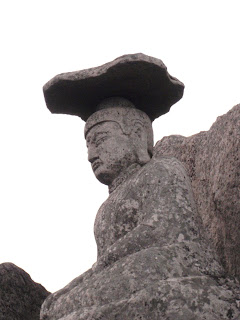Now we're finally getting to a place that has some real history. Archeologists have discovered evidence that humans inhabited Daegu during the Mumun Pottery Period, which took place between 1500 and 300 BC. However, the first written records of Daegu do not appear until the 3rd century AD. Not much is known about Daegu prior to the Silla unification of the Korean peninsula, but excavations in what is now Dalseong Park ( 달성공원 ) revealed artifacts dating to this time period. I haven't been there yet, but I will definitely go. I also saw that the city was originally named Dalgubeol. I had trouble finding the meaning of the word Daegu or Dalgubeol. However, I did see that the name was changed from Dalgubeol to Dalbulseong and Dalguhwahyeo which mean great plane and great hill. I believe the meaning of Daegu is similar, but I'm not positive.
Daegu became the official name of the city in 757 while under control of the Silla ( 신라, which is actually pronounced Shilla ) Kingdom. The Silla time period left behind some of the most popular tourist attractions, including Donghwasa Temple and Gatbawi. After the Silla unification, the peninsula was split into three kingdoms during a time period called the Later Three Kingdoms Period. Wang Geon of the Goryeo ( 고려 ) Dynasty succeeded in taking Daegu from Hubaekje Kingdom. Wang Geon would in fact go on to unify the peninsula in the year 936. The peninsula would then continue to stay united for over 1,000 years and the modern name Korea is actually derived from the name Goryeo.
The most well known artifact from the Goryeo period is the Tripitaka Koreana ( 팔만 대장경 or Palman Daejanggyeong). The Tripitaka took 16 years to complete and is the largest collection of Buddhist scriptures written in Hanja (Chinese characters that were used by Koreans prior to the invention of Hangul). The Tripitaka consists of 1,496 titles, 6,568 volumes, 81,340 wooden blocks, and 52,382,960 characters. It is currently housed in Haeinsa Temple.
The first markets in Daegu were established during the Joseon (or Choson as I've been refering to it) Dynasty ( 조선왕조 ).
During the Korean War, Daegu was right near the border of the Pusan Perimiter, but stayed under the control of South Korea throughout the entire war (Waegwan was actually directly on the border of the Pusan Perimiter). Following the Korean War Daegu began expanding very rapidly and became a Metropolitan City in 1995. It is currently the third largest metropolitan area in South Korea after Seoul and Busan.
I've had a blast in Daegu thus far. Even though it doesn't have the size of Seoul or Busan, it still has loads of attractions, stores, and bars. One gripe I've heard is that Daegu only has one downtown or party-type area, while Busan has five and Seoul has ten. But if that one area is awesome, what does it really matter?
The great thing about writing these blogs on history is that it's giving me ideas for places I want to visit in Daegu throughout the year. Well thanks for reading and I hope you learned a thing or two.


No comments:
Post a Comment